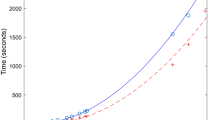Abstract
We have previously used Markov models to describe movements of patients between hospital states; these may be actual or virtual and described by a phase-type distribution. Here we extend this approach to a Markov reward model for a healthcare system with Poisson admissions and an absorbing state, typically death. The distribution of costs is evaluated for any time and expressions derived for the mean and variances of costs. The average cost at any time is then determined for two scenarios: the Therapeutic and Prosthetic models, respectively. This example is used to illustrate the idea that keeping acute patients longer in hospital to ensure fitness for discharge, may reduce costs by decreasing the number of patients that become long-stay. In addition we develop a Markov Reward Model for a healthcare system including states, where the patient is in hospital, and states, where the patient is in the community. In each case, the length of stay is described by a phase-type distribution, thus enabling the representation of durations and costs in each phase within a Markov framework. The model can be used to determine costs for the entire system thus facilitating a systems approach to the planning of healthcare and a holistic approach to costing. Such models help us to assess the complex relationship between hospital and community care.





Similar content being viewed by others
References
Bagust A, Place M and Posnett JW (1999). Dynamics of bed use in accommodating emergency admissions: stochastic simulation model. BMJ 319: 155–158.
DoH (2005a) Older people's NSF standards. Available at www.dh.gov.uk/PolicyAndGuidance/HealthAndSocialCareTopics/OlderPeoplesServices/fs/en, accessed 11 November 2005.
DoH (2005b). Reforming NHS financial flows: payment by results. http://www.dh.gov.uk/Consultations/ClosedConsultations/ClosedConsultationsArticle/fs/en?CONTENT_ID=4016901&chk=LSKQq5, accessed 3 November 2005.
DoH (2005c). NHS, Costing Manual, 2005 edn. Available at http://www.dh.gov.uk/assetRoot/04/11/35/38/04113538.pdf, accessed 3 November 2005.
DoH (2005d). NHS, National Tariff 2005/06. Available at http://www.dh.gov.uk/assetRoot/04/09/15/31/04091531.pdf, accessed 3 November 2005.
Exton-Smith AN and Millard PH (1973). Hospital services for the elderly. The care of the elderly. Proceedings of a Conference on Modeling by the Department of Health and Social Security and the British Geriatrics Society, 23 November 1973. DHSS: London.
Faddy MJ and McClean SI (2000). Analysing data on lengths of stay of hospital patients using phase-type distributions. Appl Stochastic Models and Data Analysis 15: 311–317.
Faddy MJ and McClean SI (2005). Markov chain modelling for geriatric patient care. Methods Inform Med 44: 369–373.
Graham B (1982). Compassionate Strangers. Counsel and Care: London.
Harrison GW and Millard PH (1991). Balancing acute and long-stay care: the mathematics of throughput in departments of geriatric medicine. Methods Inform Med 30: 221–228.
Himsworth RL and Goldacre MJ (1999). Does time spent in hospital in the final 15 years of life increase with age at death? A population based study. BMJ 319: 1338–1339.
Irvine V, McClean S and Millard P (1993). Stochastic models for geriatric in-patient behaviour. IMA J Math Appl Med Biol 11: 207–216.
Ivatts D and Millard PH (2002). Health care Modeling: why should we try? Br J Healthcare Mngt 8 (6): 218–222.
Marshall AH and McClean SI (2003). Conditional phase-type distributions for modeling patient length of stay in hospital. Int Transac Opl Res 10 (6): 565–576.
McClean SI (1980). A semi-Markov model for a multigrade population with Poisson recruitment. J Appl Probability 17: 846–852.
McClean S, McAlea B and Millard P (1998). Using a Markov reward model to estimate spend-down costs for a geriatric department. J Opl Res Soc 10: 1021–1025.
McClean SI, Papadopolou AA and Tsaklides G (2004). Discrete time reward models for homogeneous semi-Markov Systems. Commun Stat: Theory and Meth 33 (3): 623–638.
Millard PH (1991). A case for the development of departments of gerocomy in all district general hospitals. J R Soc Med 84: 731–733.
Pelletier C, Chaussalet T and Xie H (2005). A framework for predicting gross institutional long-term care costs from known commitments at local authority level. J Opl Res Soc 56: 144–152.
Taylor G, McClean S and Millard P (1997). Continuous-time Markov models for geriatric patient behaviour. Appl Stochastic Models and Data Anal 13: 315–323.
Taylor G, McClean S and Millard P (2000). Stochastic models of geriatric patient bed occupancy behaviour. JRSS Ser A 163 39–48.
Timm OK (1967). Rehabilitation to what? J Am Geriatrics Soc 15: 709–716.
Xie H, Chaussalet TJ and Millard PH (2005). A continuous-time Markov model for the length of stay of elderly people in institutional long-term care. J R Stat Soc Ser A: Stat Soc 168: 51–61.
Author information
Authors and Affiliations
Corresponding author
Rights and permissions
About this article
Cite this article
McClean, S., Millard, P. Where to treat the older patient? Can Markov models help us better understand the relationship between hospital and community care?. J Oper Res Soc 58, 255–261 (2007). https://doi.org/10.1057/palgrave.jors.2602173
Received:
Accepted:
Published:
Issue Date:
DOI: https://doi.org/10.1057/palgrave.jors.2602173




